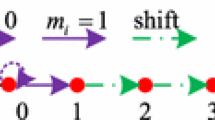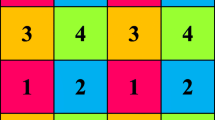Abstract
In this paper, we propose a novel reversible data hiding technique based on two-dimensional histogram shifting for quantized discrete cosine transformation coefficients (QDCT). In the proposed scheme, a two-dimensional histogram is constructed by QDCT coefficients blocks with the size of 8 × 8 of the left image and the right image. Once most of the QDCT coefficients are located at the top-right corner of the two-dimensional histogram, the QDCT coefficients are selected for embedding data to achieve high embedding capacity. In the embedding procedure, the three main steps, i.e., expanding, shifting, and embedding, are only used for QDCT coefficients in this corner not only to gain embedding capacity, but also to maintain good visual quality of stego images. The experimental results demonstrated that the proposed scheme is superior to the previous schemes in terms of embedding capacity and image quality.















Similar content being viewed by others
References
Campisi P (2008) Object-oriented stereo-image digital watermarking. J Electron Imaging 17(4):043024–043024-5
Celik MU, Sharma G, Tekalp AM, Saber E (2005) Lossless generalized-LSB data embedding. IEEE Trans Image Process 14(2):253–266
Chang C-C, Chen T-S, Chung L-Z (2002) A steganographic scheme based upon JPEG and quantization table modification. Inf Sci 141(1–2):123–138
Chang C-C, Hsiao J-Y, Chan C-S (Jul. 2003) Finding optimal least-significant-bit substitution in image hiding by dynamic programming strategy. Pattern Recogn 36(7):1583–1595
Guo J, Zheng P, Huang J (2015) Secure Watermarking Scheme against Watermark Attacks in the Encrypted Domain. J Vis Commun Image R 30:125–135
Huang F, Qu X, Kim HJ, Huang J (2016) Reversible Data Hiding in JPEG Images. IEEE Trans Circuits Syst Video Technol 26(9):1610–1621
Kumar R, Chand S (2016) A reversible high capacity data hiding scheme using pixel value adjusting feature. Multimed. Tools Appl. 75(1):241–259
Lin Y-K (2012) High capacity reversible data hiding scheme based upon discrete cosine transformation. J Syst Softw 85(10):2395–2404
Luo T, Jiang G, Wang X, Yu M, Shao F, Peng Z (2014) Stereo image watermarking scheme for authentication with self-recovery capability using inter-view reference sharing. Multimed. Tools Appl. 73(3):1077–1102
Ni Z, Shi Y-Q, Ansari N, Su W (2006) Reversible data hiding. IEEE Trans Circuits Syst Video Technol 16(3):354–362
Nikolaidis A (2015) Reversible data hiding in JPEG images utilising zero quantised coefficients. IET Image Process 9(7):560–568
S. A. Parah, J. A. Akhoon, J. A. Sheikh, N. A. Loan, and G. M. Bhat, “A high capacity data hiding scheme based on edge detection and even-odd plane separation,” in 2015 Annual IEEE India Conference (INDICON), 2015, pp. 1–5
S. A. Parah, F. Ahad, J. A. Sheikh, and G. M. Bhat, “On the realization of robust watermarking system for medical images,” in 2015 Annual IEEE India Conference (INDICON), 2015, pp. 1–5
Parah SA, Sheikh JA, Loan NA, Bhat GM (2016) Robust and blind watermarking technique in DCT domain using inter-block coefficient differencing. Digit Signal Process 53:11–24
Parah SA, Sheikh JA, Assad UI, Bhat GM (2017) Realisation and robustness evaluation of a blind spatial domain watermarking technique. Int J Electron 104(4):659–672
Parah SA, Ahad F, Sheikh JA, Loan NA, Bhat GM (2017) A New Reversible and high capacity data hiding technique for E-healthcare applications. Multimed. Tools Appl. 76(3):3943–3975
Parah SA, Sheikh JA, Ahad F, Loan NA, Bhat GM (2017) Information hiding in medical images: a robust medical image watermarking system for E-healthcare. Multimed. Tools Appl. 76(8):10599–10633
Parah SA, Sheikh JA, Akhoon JA, Loan NA, Bhat GM (2018) Information hiding in edges: A high capacity information hiding technique using hybrid edge detection. Multimed. Tools Appl. 77(1):185–207
F. PUB, Data Encryption Standard (DES). 1999
F. PUB, Advanced Encryption Standard (AES). 2011
Rivest RL, Shamir A, Adleman L (1978) A Scheme for Obtaining Digital Signatures and Public-key Cryptosystems. Commun ACM 21(2):120–126
J. Shade, S. Gortler, L. He, R. Szeliski (1998) “Layered Depth Images,” in Proceedings of the 25th Annual Conference on Computer Graphics and Interactive Techniques, New York, NY, USA, pp. 231–242
Tian J (2003) Reversible data embedding using a difference expansion. IEEE Trans. Circuits Syst. Video Technol. 13(8):890–896
“vision.middlebury.edu/stereo/data.” [Online]. Available: http://vision.middlebury.edu/stereo/data/. [Accessed: 31-Dec-2016]
Wang K, Lu Z-M, Hu Y-J (2013) A high capacity lossless data hiding scheme for JPEG images. J Syst Softw 86(7):1965–1975
Yang W-C, Chen L-H (2015) Reversible DCT-based data hiding in stereo images. Multimed Tools Appl 74(17):7181–7193
Acknowledgements
This research is funded by Vietnam National Foundation for Science and Technology Development (NAFOSTED) under grant number 102.01-2016.06
Author information
Authors and Affiliations
Corresponding author
Rights and permissions
About this article
Cite this article
Vo, PH., Nguyen, TS., Huynh, VT. et al. A novel reversible data hiding scheme with two-dimensional histogram shifting mechanism. Multimed Tools Appl 77, 28777–28797 (2018). https://doi.org/10.1007/s11042-018-5991-8
Received:
Revised:
Accepted:
Published:
Issue Date:
DOI: https://doi.org/10.1007/s11042-018-5991-8




